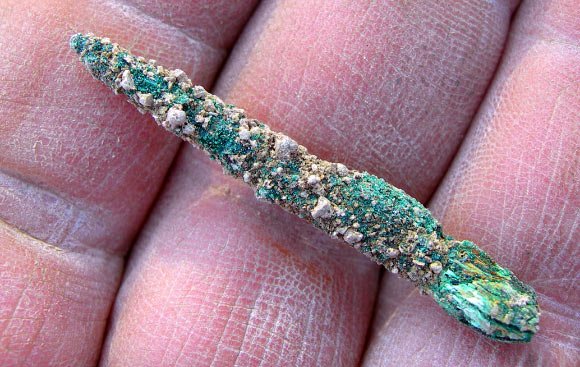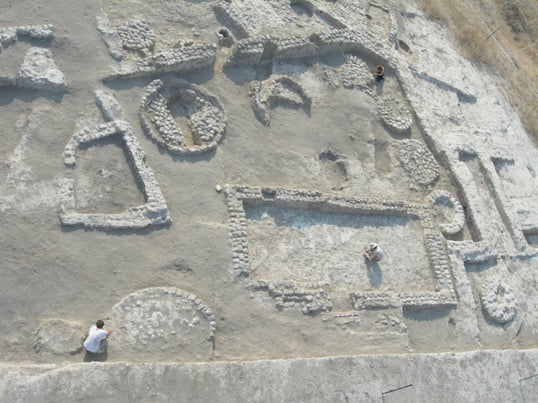A copper awl, the oldest metal object found to date in the Middle East, was discovered during the excavations at Tel Tsaf, according to a recent study published by researchers from the Zinman Institute of Archaeology at the University of Haifa.
According to the study, which appeared in the prestigious journal “PLOS One,” the awl, a long pointed spike, dates back to the late 6th millennium or the early 5th millennium BCE, moving back by several hundred years the date it was previously thought that the peoples of the region began to use metals.
A small finding with big meaning
Tel Tsaf, a Middle Chalcolithic village dated to about 5200-4600 BCE, is located near the Jordan River and Israel’s border with Jordan. The site was first documented in the 1950s and excavations there began at the end of the 1970s. From the earliest digs nearly 40 years ago, this area, the most important archeological site in the region dated to this period, has been supplying researchers with a great deal of valuable data.
SEE ALSO: No Camels: Radiocarbon Shows Domesticated Camels Didn’t Exist During Biblical Times
Yet the most important finding to date is only 4 centimeters long. In the current research project led by Dr. Danny Rosenberg this unique item, a copper awl measuring 1 millimeter thick at the tip that was set in a wooden handle, was actually found during a previous excavation at the site by Prof. Yosef Garfinkel of the Hebrew University. The cone-shaped awl was found in a sealed grave of a woman about 40 years old that was dug inside a silo, and around her waist was a belt made of 1,668 ostrich-egg shell beads. The grave was covered with several large stones, and according to Dr. Rosenberg, its location within a silo testifies to both the importance of the deceased and the importance the community ascribed to the facility in which she was buried.
 But while the grave, the woman’s skeleton, and the beaded belt were all previously reported in scientific journals, the little awl was only reported on recently, after its chemical components were analyzed by Prof. Sariel Shalev also from the University of Haifa. As noted, the awl was found to be made of copper, and according to Dr. Rosenberg, the fact that it was found just above the skeleton in a sealed grave, meant that it was buried with the woman, apparently as a burial offering, and may have belonged to her.
But while the grave, the woman’s skeleton, and the beaded belt were all previously reported in scientific journals, the little awl was only reported on recently, after its chemical components were analyzed by Prof. Sariel Shalev also from the University of Haifa. As noted, the awl was found to be made of copper, and according to Dr. Rosenberg, the fact that it was found just above the skeleton in a sealed grave, meant that it was buried with the woman, apparently as a burial offering, and may have belonged to her.
Metal first put into use later than previously thought
This artifact is important because until now, researchers believed that area residents began to use metals only in the Late Chalcolithic period (during the second half of the 5th millennium BCE) so that this finding moves back the appearance of metal in our region by several hundred years. This has significant impact on our understanding of the developing use of complex technologies and the related social contexts.
Sign up for our free weekly newsletter
SubscribeBut this is not the only reason the awl is significant. The chemical examination of the metal shows it may have come from the Caucasus, some 1,000 kilometers from Tel Tsaf. According to Dr. Rosenberg, while the long-distance commercial ties maintained by village communities in our region were already known from even earlier periods, the import of a new technology combined with the processing of a new raw material coming from such a distant location is unique to Tel Tsaf and provides additional evidence of the importance of this site in the ancient world.
SEE ALSO: Israeli App Brings Archaeological Landmarks Back To Life
The researchers are still not sure what the awl was used for, but the early use of a metal object, as well as its distant source, also testify to the high social status of the woman and the importance of the building she was buried in.
“The appearance of the item in a woman’s grave, which represents one of the most elaborate burials we’ve seen in our region from that era, testifies to both the importance of the awl and the importance of the woman, and it’s possible that we are seeing here the first indications of social hierarchy and complexity,” said Dr. Rosenberg. “However, in this area far more is unknown than is known, and although the discovery of the awl at Tel Tsaf constitutes evidence of a peak of technological development among the peoples of the region and is a discovery of global importance, there’s a lot of progress still to be made and many parts of the wider picture are still unknown to us”.
“It seems that at least some of the questions raised by this unique item will be answered by an interdisciplinary research project we have been conducting at the site since last year,” Dr. Rosenberg continued. “This project integrates multi-national archeologists and researchers from a variety of other scientific disciplines, who will address the even more complex questions that will undoubtedly arise.”
The research at Tel Tsaf was conducted by Dr. Danny Rosenberg of Department of Archaeology at the University of Haifa, in conjunction with researchers Prof. Yosef Garfinkel of the Hebrew University of Jerusalem and Dr. Florian Klimscha of the German Archaeological Institute in Berlin.
Photos: Wikipedia/Yosef Garfinkel / University of Haifa
Related posts

Resilient And Nutritious New Plant-Based Milk Aims To Make A Splash

Chocolate From Cultivated Cocoa Comes Without Environmental Toll

Plastic Fantastic: Startup Takes PVC Back To Its Crude Oil Roots






Facebook comments